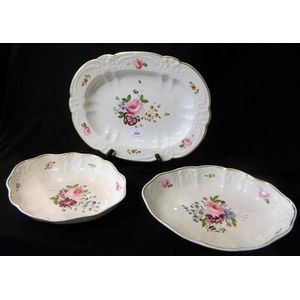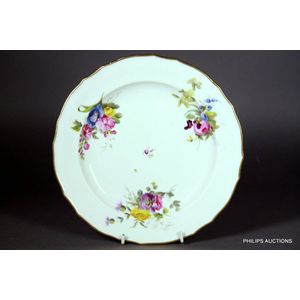Imperial Porcelain Dishes with Garden Flowers
You must be a subscriber, and be logged in to view price and dealer details.
Subscribe Now to view actual auction price for this item
When you subscribe, you have the option of setting the currency in which to display prices to $Au, $US, $NZ or Stg.
- Basket Weave / Basketweave - Basket weave is a decorative pattern that is often used in textiles, ceramics, furniture and other decorative arts. It is created by actual or simulated interweaving of horizontal and vertical threads or strips to create a pattern that resembles a woven basket.
In textiles, basket weave can be created using various materials such as fabric, yarn, or ribbon. It is often used to create decorative details on clothing, upholstery, and other household items. Simulated basket weave can also be created using ceramic clay, timber or other materials, and it is often used to decorate pottery, tiles, furniture, silver and other decorative objects.
Basket weave patterns can vary in complexity, from simple, straightforward designs to more intricate, elaborate patterns. The size and spacing of the interwoven threads or strips can also be varied to create different effects. Basket weave is often used to create a natural, rustic look and is often associated with traditional crafts and folk art. - Circa - A Latin term meaning 'about', often used in the antique trade to give an approximate date for the piece, usually considered to be five years on either side of the circa year. Thus, circa 1900 means the piece was made about 1900, probably between 1895 and 1905. The expression is sometimes abbreviated to c.1900.
- Polychrome - Made or finished in many colours. For furniture, it is used to indicated a painted finish.
- Incised - A record of a name, date or inscription, or a decoration scratched into a surface, usually of a glass or ceramic item with a blunt instrument to make a coarse indentation. Compare with engraving where the surface is cut with a sharp instrument such as a metal needle or rotating tool to achieve a fine indentation.
This item has been included into following indexes:
- Russian
Visually similar items

A Royal Crown Derby serving platter and two bowls, c.1820

A rare Derby dessert plate decorated by William Billingsley, circa 1785, pattern 80, a gently lobed plate with a gilded rim, finely painted with loose polychrome posies of summer flowers; purple painted mark underside; similar in the Royal crown Derby Muse

A Wedgwood floral plate, circa 1812-22, with a central loose posy in pink, purple and orange colours, and three sprigs to the fluted border; red printed Wedgwood mark underside, diameter 21.5 cm

A set of six Frank Haviland Limoges handpainted plates
